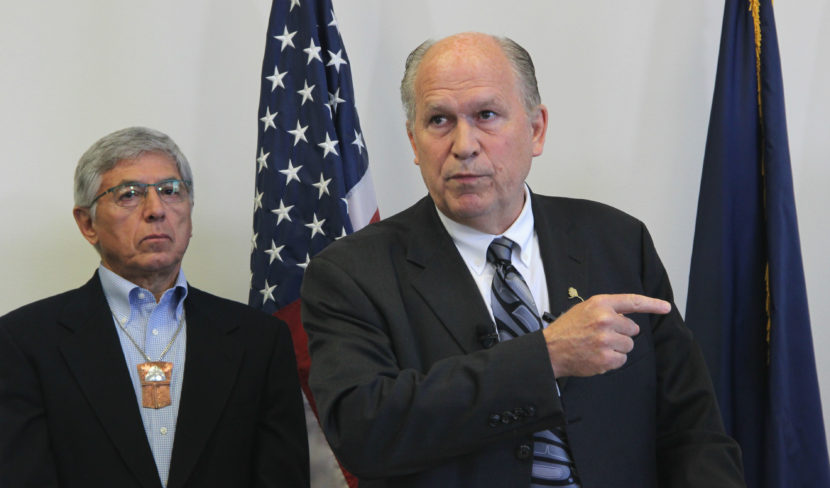
Gov. Bill Walker proposed a state budget that again seeks to draw nearly $2 billion from Permanent Fund earnings, and cap Permanent Fund dividends. But Walker left an $890 million budget gap, saying he wants to work with lawmakers to close it.
The proposal also cuts the number of state workers by 400.
Walker’s proposed spending plan totals $10.4 billion for the fiscal year starting on July 1, but much of that is federal funding. The budget includes $4.3 billion for the part of the budget directly controlled by the legislature.
The amount of money raised through taxes and fees is projected to increase by $177.4 million. But that still leaves a large gap that Walker would like to close. State Revenue Commissioner Randall Hoffbeck said Walker decided to leave an $890 million gap between state spending and the taxes and fees it collects because he wants to work with the legislature.
“I think it really is a recognition that the administration and the legislature are in this together,” Hoffbeck said. “Last year, we proposed a slate of bills that would get us to the finish line. Some were received more openly than others. And so what we felt like is that this year we would go in with a little bit more of an open-ended plan.”
Walker wants to close most of the budget gap with legislation that would draw $1.87 billion from Permanent Fund earnings, and keep dividends at $1,000 per person. That’s about the same level residents received this year, after Walker vetoed half of dividend funding.
Walker is proposing the same Permanent Fund bill the Senate passed in the summer, but the House didn’t act on. Hoffbeck said that approach may save time and effort.
“I think it’s more pragmatic than anything else,” Hoffbeck said. “The Senate has already weighed in on this and were willing to pass this particular version of the plan. So rather than trying to start all over again, we already got half the battle won.”
The incoming House majority caucus will be different than this year. This year, the majority was led by Republicans. In the coming year, it will be predominantly Democratic.
The proposed budget includes a $123 million cut in spending by state agencies. The cuts are offset by higher payments on state debt, oil and gas tax credits, and capital projects, leaving the total budget reduction at $28 million.
State Budget Director Pat Pitney said preparing the budget was difficult.
“We’re trying to find savings out of a very small segment” of the budget, she said. “When you have the statutory required programs, whether it be oil and gas tax credits, whether it’s Medicaid, whether it’s Base Student Allocation” that forms the basis of state funding for schools.
Further budget changes could include introducing a personal income tax and/or a sales tax or another tax on consumption.
Pitney says the legislative changes made this year could phase in new money over a year or two.
Walker is focused on adding a personal income tax, but Hoffbeck said some legislators are working on a statewide consumption tax. He said this could include a value added tax, in which taxes are applied at each stage of production of a good or service. Or it could be a gross receipts tax, which would be applied to a business’s total sales.
The proposed budget includes the minimum amount of oil and gas tax credits under state law. That means nearly $1 billion in credits that energy companies are due wouldn’t be paid out in the coming year. Pitney said Walker would support making those payments if the legislature makes further changes to the oil and gas tax system that Walker proposed last year and provides funding for the credits.
There was one tax increase Walker’s plan did spell out – increasing the motor fuel tax from the current level of 8 cents per gallon to 16 cents in July, and adding another 8 cents the following year. Hoffbeck said it’s a prudent approach.
“It would ultimately top out at 24 cents a gallon, which is about the national average motor fuel tax,” she said.
Walker’s proposal received a mixed response. Eagle River Republican Sen. Anna MacKinnon said she’s disappointed the administration didn’t “take their job more seriously and identify areas that should be cut, trimmed or eliminated.”
Democratic House Speaker Bryce Edgmon said there is no question Walker is willing to address the state’s fiscal challenge head on and he said the new House majority coalition would give Walker’s proposals a fair hearing.
